A Linear Quadratic Regression-Based Synchronised Health Monitoring System (SHMS) for IoT Applications
Abstract
1. Introduction
- This paper aims to design an efficient IoT-aware health monitoring system that leverages the characteristics of various body and room sensors at the physical layer. It helps provide efficient nursing care while sustaining the quality of services at the application layer.
- Deployment of a network-layered architecture includes generating data at the physical layer to access, process, and transmit data at the network layer for analysis and decision-making at the decision-support layer, and application support for health care practitioners and patient caretakers.
- Analytical proof that the proposed system results in increased healthcare facilities and reduces the effort of the medical consultants. The data collected during the process are also accurate and will be analysed.
- The proposed system is also reviewed through simulations discussing the collected and actual data during the monitoring process. The results observed the proposed solution’s gain and ease of use.
2. Literature Review
3. Architecture Overview
4. Results and Analysis of the Health Monitoring System
4.1. Phase 1: Health Monitoring System Analysis
4.2. Phase 2: Synchronising the Clock Skew of the Monitoring System
4.3. The Linear Quadratic Regression Model
4.4. The Linear Quadratic Regression Model for Estimating Clock Skew
4.4.1. Input Selection
4.4.2. Algorithm for Calculating
- Calculate ∆αA,(t), i.e., the clock skews between two sensor nodes, A and B.
- Apply ∆αA,(t), …, ∆αA,B(t−2) ∆αA,B(t−p−1) and t1, t2, …, tn as input to a linear quadratic regression processor.
- Apply linear regression with quadratic type to calculate . The quadratic model works on a linear term, an intercept, square terms, and an interaction.
4.5. Model Validation
4.6. Performance Evaluation
5. Conclusions
Author Contributions
Funding
Data Availability Statement
Acknowledgments
Conflicts of Interest
References
- Ngu, A.H.; Gutierrez, M.; Metsis, V.; Nepal, S.; Sheng, Q.Z. IoT middleware: A survey on issues and enabling technologies. IEEE Internet Things J. 2017, 4, 1–20. [Google Scholar] [CrossRef]
- Raggett, D. The Web of Things: Challenges and Opportunities. Computer 2015, 48, 26–32. [Google Scholar] [CrossRef]
- Want, R.; Schilit, B.N.; Jenson, S. Enabling the Internet of Things. Computer 2015, 48, 28–35. [Google Scholar] [CrossRef]
- Tournier, J.; Lesueur, F.; Le Mouël, F.; Guyon, L.; Ben-Hassine, H. A survey of IoT protocols and their security issues through the lens of a generic IoT stack. Internet Things 2021, 16, 100264. [Google Scholar] [CrossRef]
- Catarinucci, L.; De Donno, D.; Mainetti, L.; Palano, L.; Patrono, L.; Stefanizzi, M.L.; Tarricone, L. An IoT-Aware Architecture for Smart Healthcare Systems. IEEE Internet Things J 2015, 2, 515–526. [Google Scholar] [CrossRef]
- Health Strateg. Available online: https://www.unicef.org/health/files/UNICEF_Health_Strategy_Final.pdf (accessed on 12 December 2018).
- Yang, G.; Xie, L.; Mäntysalo, M.; Zhou, X.; Pang, Z.; Da Xu, L.; Kao-Walter, S.; Chen, Q.; Zheng, L.R. A Health-IoT Platform Based on the Integration of Intelligent Packaging, Unobtrusive Bio-Sensor, and Intelligent Medicine Box. IEEE Trans. Ind. Inform. 2014, 10, 2180–2191. [Google Scholar] [CrossRef]
- Lakshmanan, A.; Agni, M.; Lieu, T.; Fleegler, E.; Kipke, M.; Friedlich, P.S.; McCormick, M.C.; Belfort, M.B. The impact of preterm birth < 37 weeks on parents and families: A cross-sectional study in the 2 years after discharge from the neonatal intensive care unit. Health Qual. Life Outcomes 2017, 15, 1–13. [Google Scholar] [CrossRef]
- Khazaei, H.; Mench-Bressan, N.; McGregor, C.; Pugh, J.E. Health Informatics for Neonatal Intensive Care Units: An Analytical Modeling Perspective. IEEE J. Transl. Eng. Health Med. 2015, 3, 1–9. [Google Scholar] [CrossRef] [PubMed]
- Kramer, M.S.; Platt, R.; Yang, H.; Joseph, K.S.; Wen, S.W.; Morin, L.; Usher, R.H. Secular trends in preterm birth: A hospital-based cohort study. JAMA 1998, 280, 1849–1854. [Google Scholar] [CrossRef] [PubMed]
- Minerva, R.; Biru, A.; Rotondi, D. Towards a Definition of the Internet of Things (IoT). IEEE Internet Initiat. 2015, 1, 1–86. [Google Scholar]
- Ray, P.P. A survey on Internet of Things architectures. J. King Saud Univ. Comput. Inf. Sci. 2018, 30, 291–319. [Google Scholar] [CrossRef]
- Redondi, A.; Chirico, M.; Borsani, L.; Cesana, M.; Tagliasacchi, M. An integrated system based on wireless sensor networks for patient monitoring localisation and tracking. Ad Hoc Netw. 2013, 11, 39–53. [Google Scholar] [CrossRef]
- Mohammad, G.B.; Shitharth, S.; Syed, S.A.; Dugyala, R.; Rao, K.; Alenezi, F.; Althubiti, S.A.; Polat, K. Mechanism of Internet of Things (IoT) Integrated with Radio Frequency Identification (RFID) Technology for Healthcare System. Math. Probl. Eng. 2022, 2022, 4167700. [Google Scholar] [CrossRef]
- De, D.; Mukherjee, A.; Sau, A.; Bhakta, I. Design of smart neonatal health monitoring system using SMCC. Healthc. Technol. Lett. 2016, 4, 13–19. [Google Scholar] [CrossRef] [PubMed]
- Hakimi, A.; Hassan, N.; Anwar, K.; Zakaria, A.; Ashraf, A. Development of real-time patient health (jaundice) monitoring using wireless sensor network. In Proceedings of the 3rd International Conference on Electronic Design (ICED), Phuket, Thailand, 11–12 August 2016; pp. 404–409. [Google Scholar]
- Santhi, S.; Gandhi, A.; Geetha, M.; Nirmala, K.J.B.I.J. Smart Maternal Healthcare Monitoring System using Wireless Sensors Network. BioTechnol. Indian J. 2016, 12, 1–7. [Google Scholar]
- Martínez Chávez, S.M.; Rivero-Angeles, M.E.; Garay-Jiménez, L.I.; Romero Ibarra, I.C. Priority Schemes for Life Extension and Data Delivery in Body Area Wireless Sensor Networks with Cognitive Radio Capabilities. Wirel. Commun. Mob. Comput. 2019, 2019, 2637830. [Google Scholar] [CrossRef]
- Amendola, S.; Lodato, R.; Manzari, S.; Occhiuzzi, C.; Marrocco, G. RFID Technology for IoT-Based Personal Healthcare in Smart Spaces. IEEE Internet Things J. 2014, 1, 144–152. [Google Scholar] [CrossRef]
- Abdellatif, A.A.; Khafagy, M.G.; Mohamed, A.; Chiasserini, C.-F. EEG-Based Transceiver Design With Data Decomposition for Healthcare IoT Applications. IEEE Internet Things J. 2018, 5, 3569–3579. [Google Scholar] [CrossRef]
- Hooshmand, M.; Zordan, D.; Del Testa, D.; Grisan, E.; Rossi, M. Boosting the Battery Life of Wearables for Health Monitoring Through the Compression of Biosignals. IEEE Internet Things J. 2017, 4, 1647–1662. [Google Scholar] [CrossRef]
- Del Testa, D.; Rossi, M. Lightweight lossy compression of biometric patterns via denoising auto encoders. IEEE Signal Process. Lett. 2015, 22, 2304–2308. [Google Scholar] [CrossRef]
- Xu, G.; Han, J.; Zou, Y.; Zeng, X. A 1.5-D Multi-Channel EEG Compression Algorithm Based on NLSPIHT. IEEE Signal Process. Lett. 2015, 22, 1118–1122. [Google Scholar] [CrossRef]
- Carotti, E.S.; De Martin, J.C.; Merletti, R.; Farina, D. Compression of Multidimensional Biomedical Signals with Spatial and Temporal Codebook-Excited Linear Prediction. IEEE Trans. Biomed. Eng. 2009, 56, 2604–2610. [Google Scholar] [CrossRef] [PubMed]
- Akiike, J. Slurry for Lithium Ion Secondary Battery Porous Film, Production Method Therefor, Separator for Lithium Ion Secondary Battery, and Lithium Ion Secondary Battery. U.S. Patent Application No. 2016/0,013,465, 17 August 2021. [Google Scholar]
- Patil, S.P.; Mhetre, M.R. Intelligent patient monitoring system. Trans. Electr. Electron. Eng. 2014, 2, 2320–8945. [Google Scholar]
- Patke, H.; Borkar, M.; Kenkre, N.; Gupta, A. An innovative approach for infant monitoring system using pulse rate and oxygen level. In Proceedings of the 2017 International Conference on Intelligent Computing and Control Systems (ICICCS), Madurai, India, 15–16 June 2017; pp. 0975–8887. [Google Scholar]
- Angelov, G.V.; Nikolakov, D.P.; Ruskova, I.N.; Gieva, E.E.; Spasova, M.L. Healthcare Sensing and Monitoring. In Enhanced Living Environments; Lecture Notes in Computer Science; Ganchev, I., Garcia, N., Dobre, C., Mavromoustakis, C., Goleva, R., Eds.; Springer: Berlin/Heidelberg, Germany, 2019; pp. 226–262. [Google Scholar] [CrossRef]
- Nirmala, G.; Jeyashree, S.; Murugalakshmi, B.; Nandhin, K. A secure IoT based patient healthcare monitoring and maintenance system in cloud. Int. J. Curr. Eng. Sci. Res. 2018, 5, 2393–8374. [Google Scholar]
- Birje, M.N.; Hanji, S.S. Internet of things based distributed healthcare systems: A review. J. Data Inf. Manag. 2020, 2, 149–165. [Google Scholar] [CrossRef]
- Habibzadeh, H.; Dinesh, K.; Shishvan, O.R.; Boggio-Dandry, A.; Sharma, G.; Soyata, T. A Survey of Healthcare Internet of Things (HIoT): A Clinical Perspective. IEEE Internet Things J. 2019, 7, 53–71. [Google Scholar] [CrossRef]
- Haghi, M.; Neubert, S.; Geissler, A.; Fleischer, H.; Stoll, N.; Stoll, R.; Thurow, K. A Flexible and Pervasive IoT-Based Healthcare Platform for Physiological and Environmental Parameters Monitoring. IEEE Internet Things J. 2020, 7, 5628–5647. [Google Scholar] [CrossRef]
- Sun, J.; Xiong, H.; Liu, X.; Zhang, Y.; Nie, X.; Deng, R.H. Lightweight and Privacy-Aware Fine-Grained Access Control for IoT-Oriented Smart Health. IEEE Internet Things J. 2020, 7, 6566–6575. [Google Scholar] [CrossRef]
- Mishura, Y.; Ralchenko, K.; Shklyar, S. Maximum likelihood estimation for Gaussian process with non-linear drift. Nonlinear Anal. Model. Control. 2018, 23, 120–140. [Google Scholar] [CrossRef]
- Yang, Z.; Cai, L.; Liu, Y.; Pan, J. Environment-aware clock skew estimation and synchronisation for wireless sensor networks. In Proceedings of the 2012 Proceedings IEEE INFOCOM, Orlando, FL, USA, 25–30 March 2012; pp. 1017–1025. [Google Scholar]
- Khandoker, T.U.I.; Huang, D.; Sreeram, V. A low complexity linear regression approach to time synchronisation in underwater networks. In Proceedings of the 2011 8th International Conference on Information, Communications & Signal Processing, Singapore, 13–16 December 2011; pp. 1–5. [Google Scholar]
- Jeong, S.; Kim, S.C. Time Synchronization for Underwater Cellular Networks. In Proceedings of the 2017 International Conference on Information Networking (ICOIN), Da Nang, Vietnam, 11–13 January 2017; pp. 512–517. [Google Scholar]


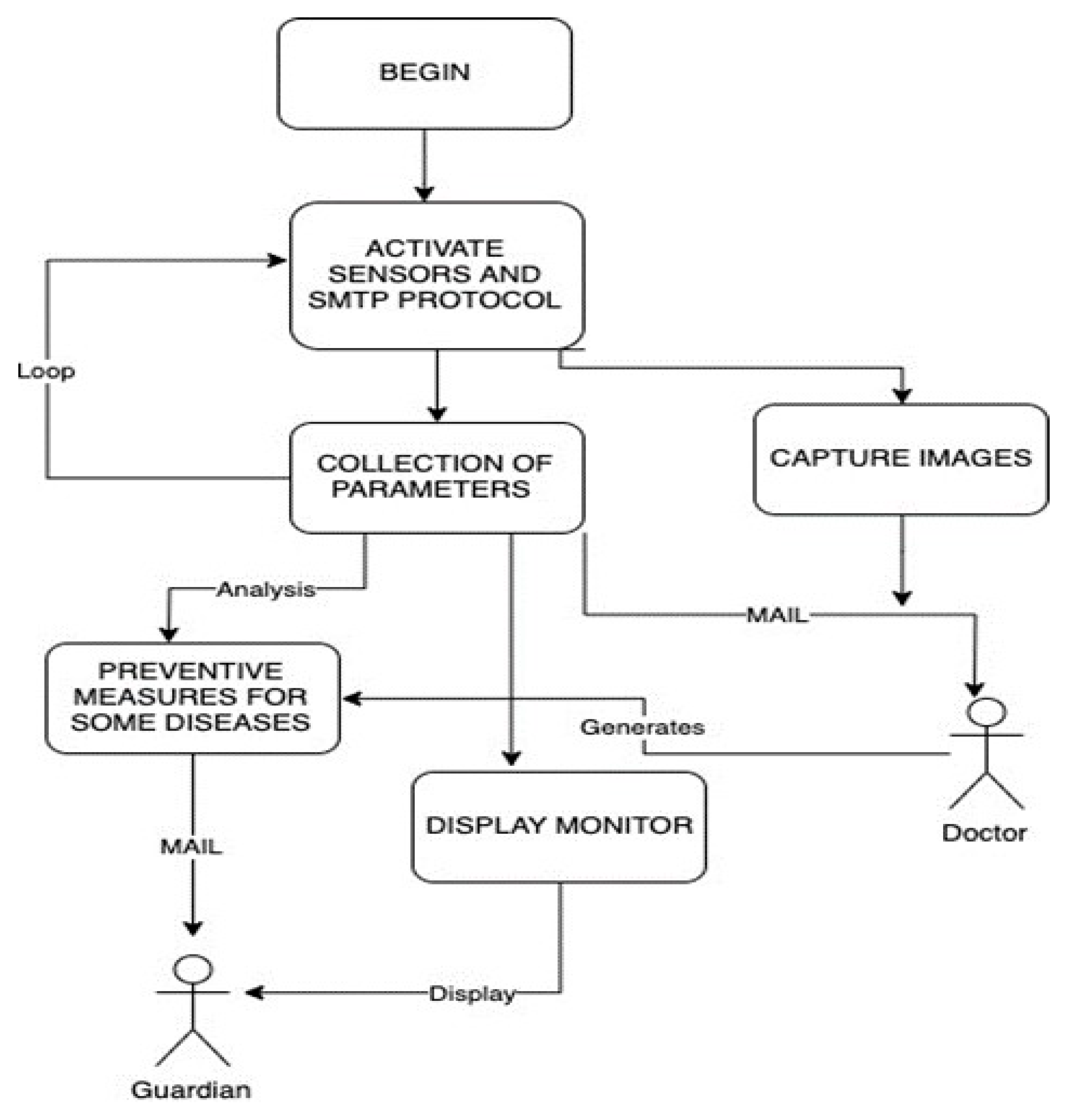

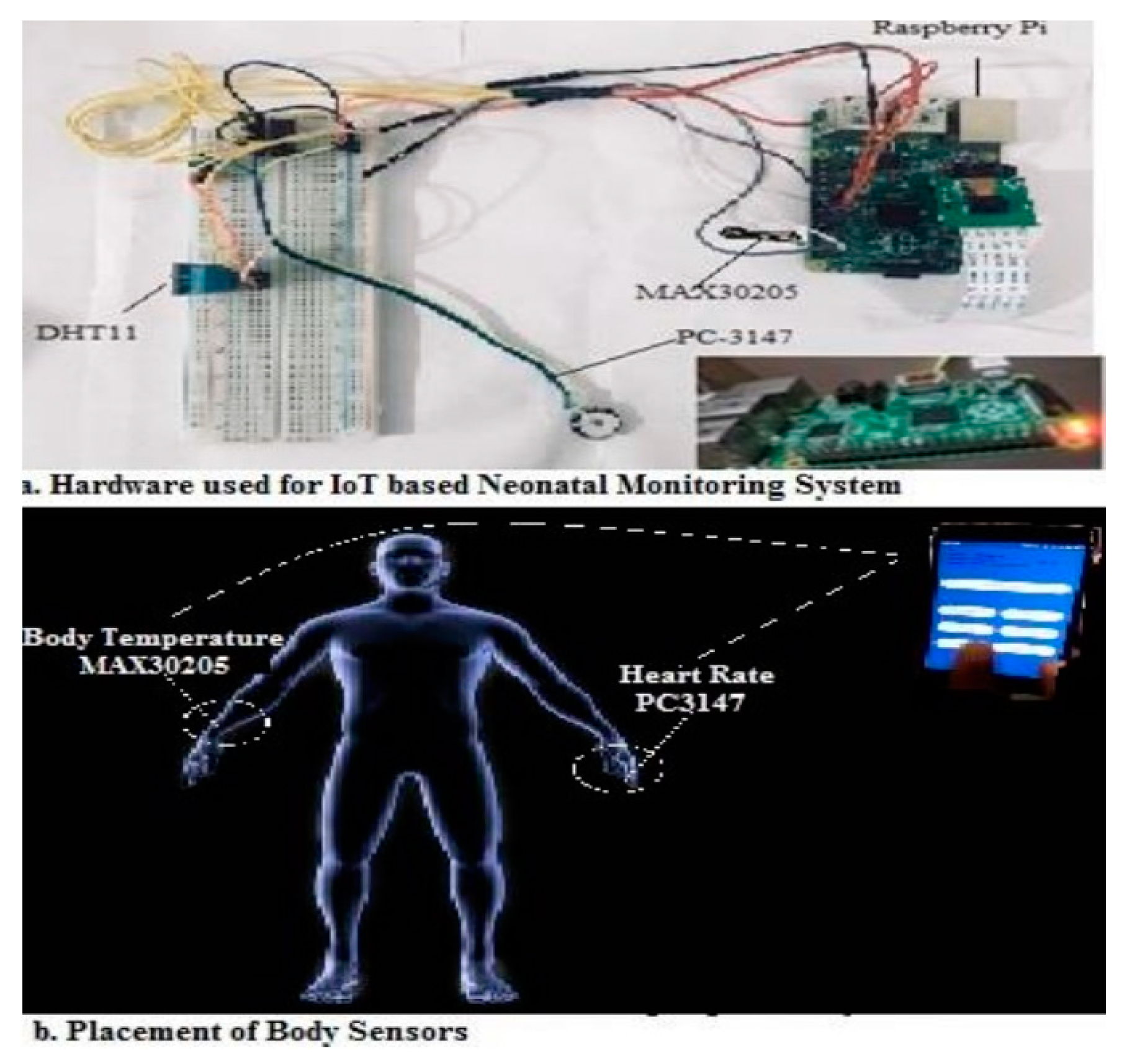





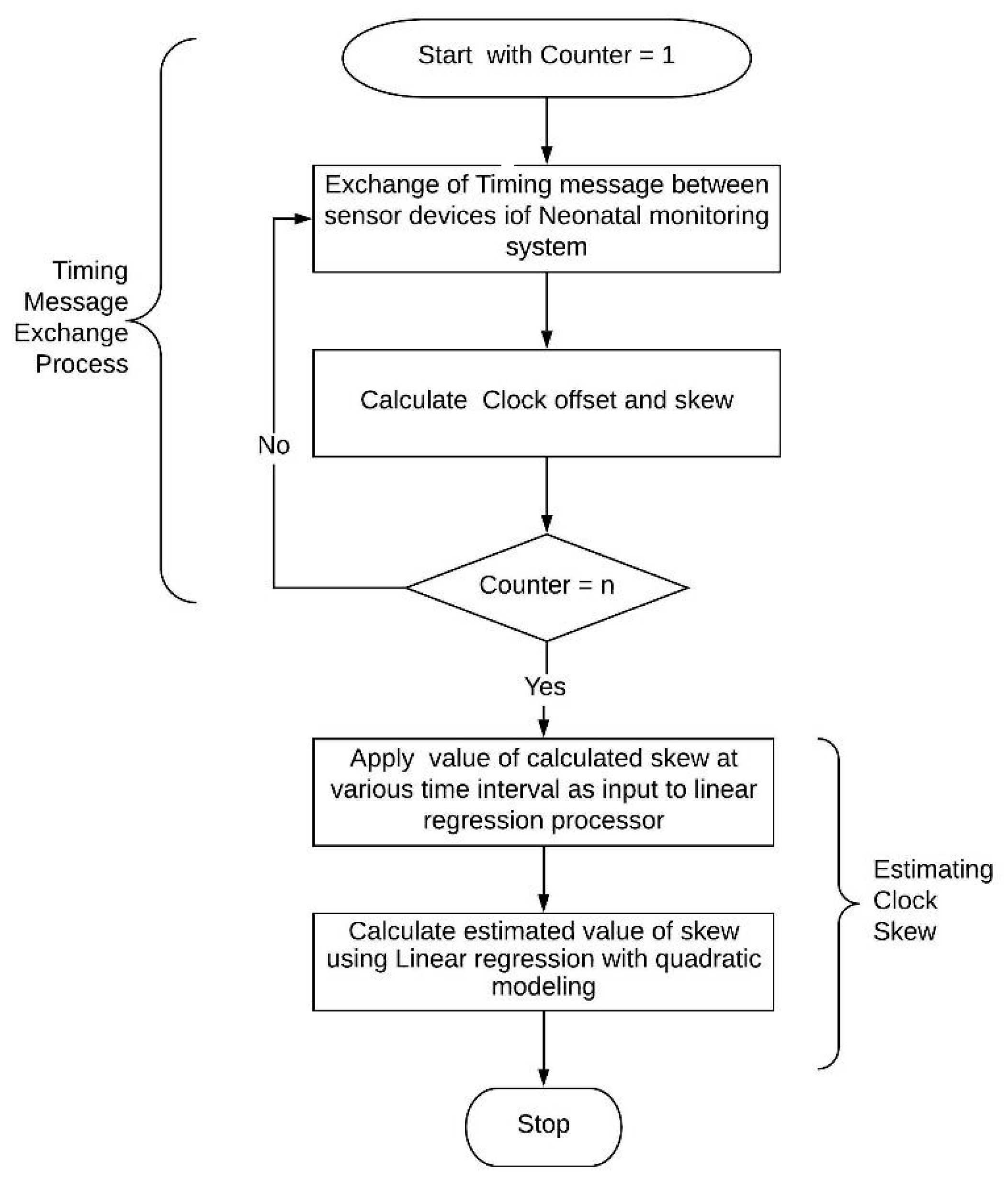
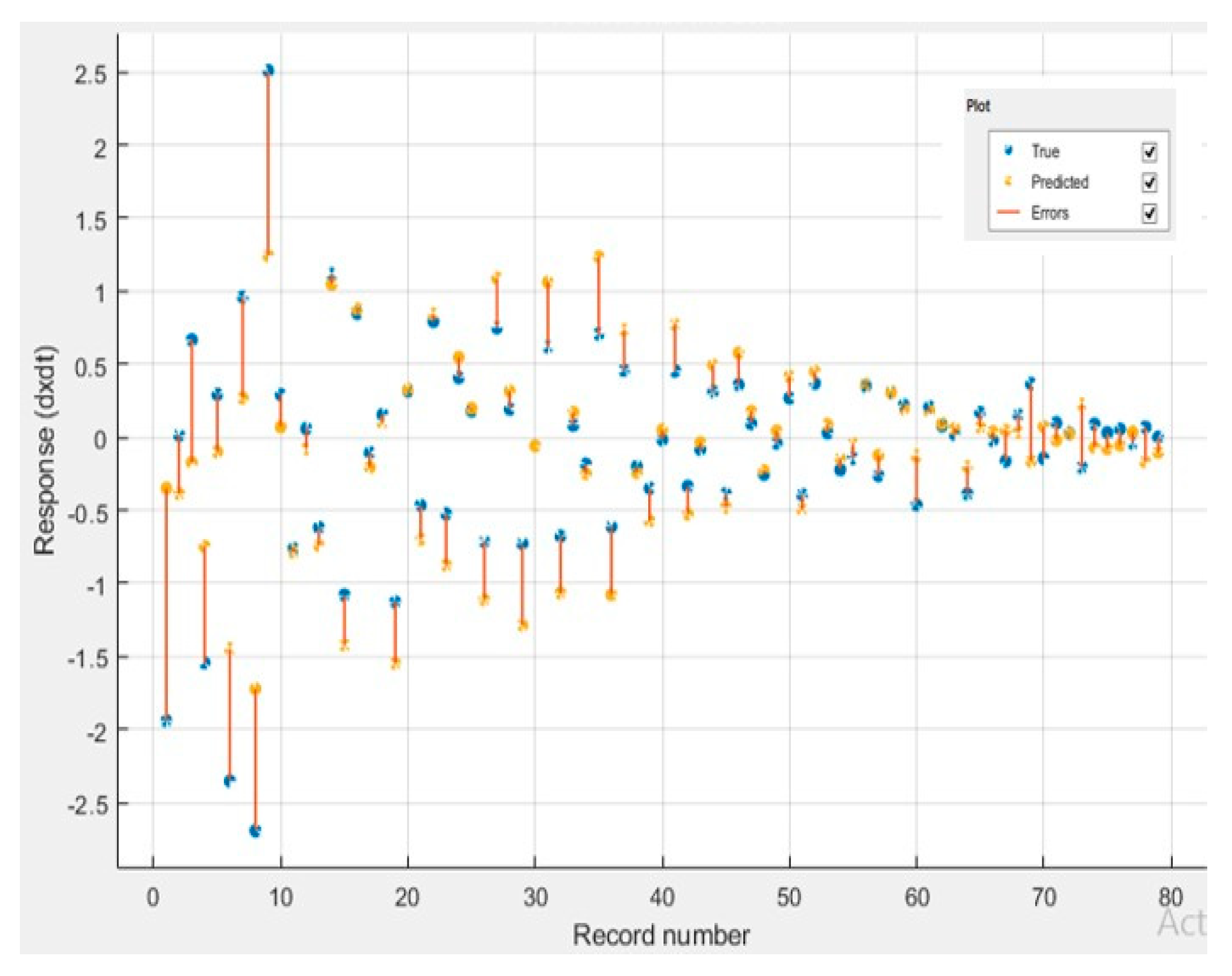
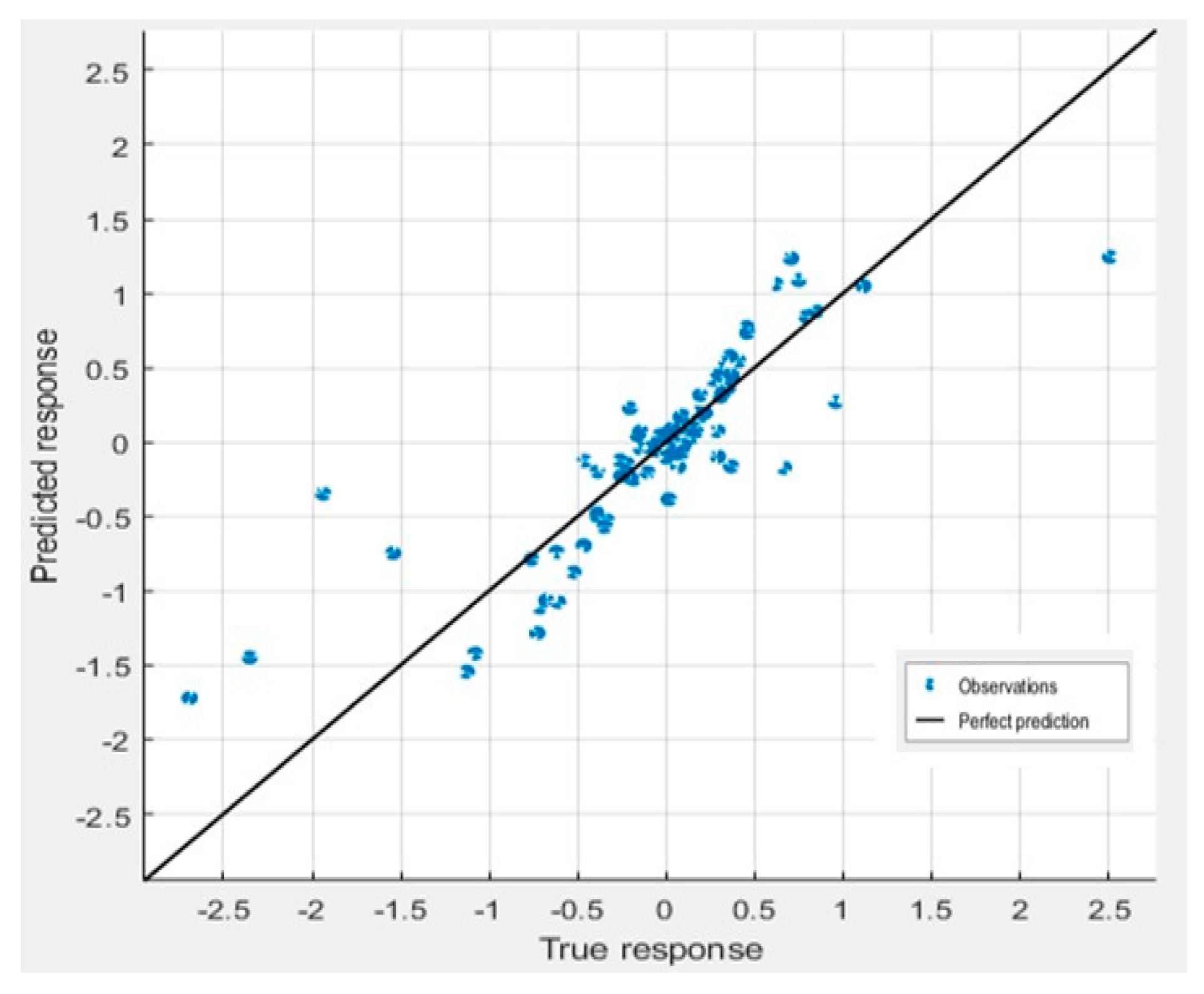
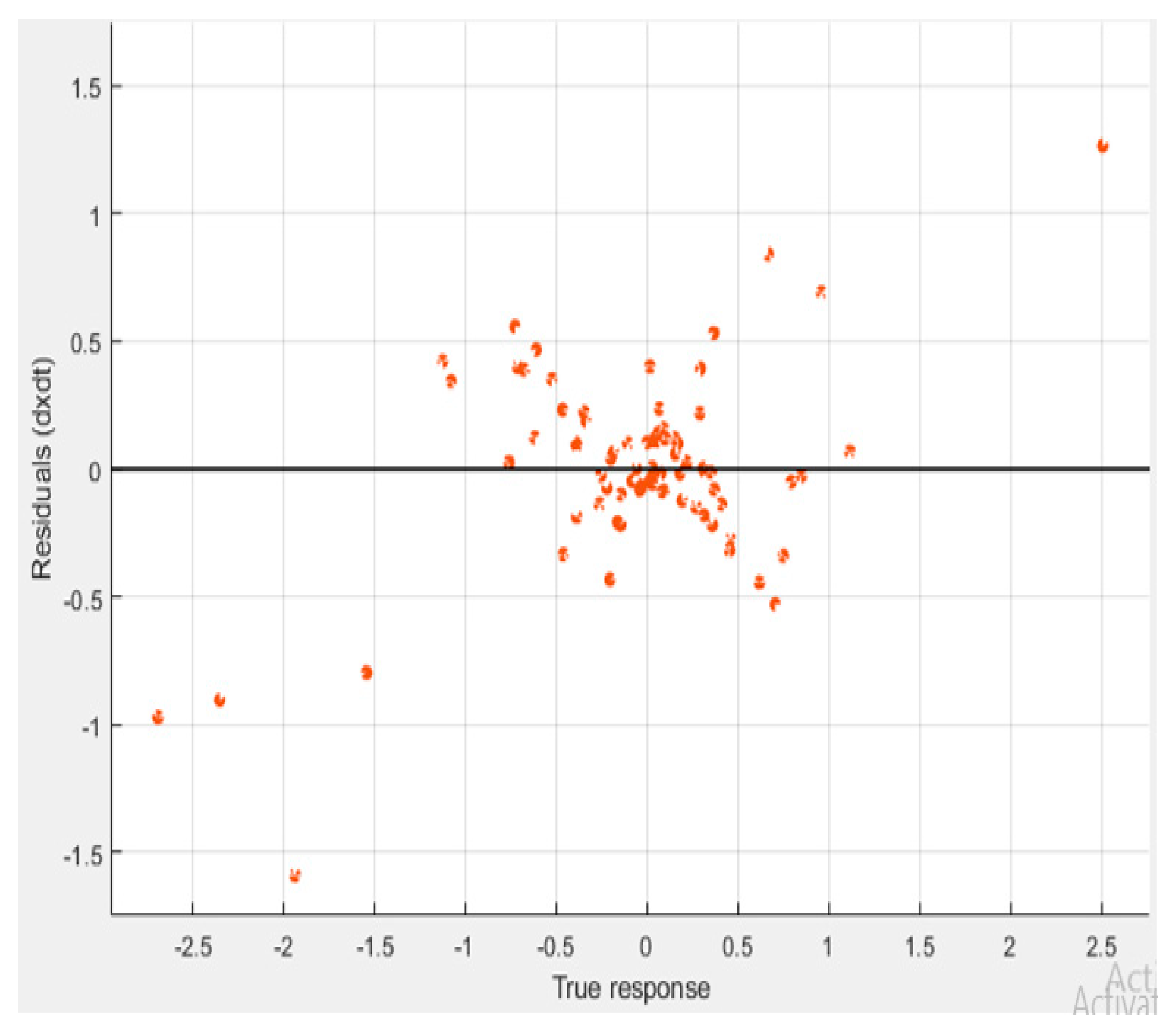
| Parameters | Value |
|---|---|
| ZigBee module | XBP24-ZB |
| GPRS module | MTSMC-G2-SP |
| Architecture | Single-tier heterogeneous |
| Transmission range | ≤25 m |
| Heartrate sensor | PC-3147 |
| Body temperature sensor | MAX30205 |
| Room temperature sensor | DHT11 |
| Humidity sensor | DHT11 |
| Visual monitoring | Pi camera |
| Data upload interval | 10 min |
| Characteristics | Smart Health Monitoring Application |
|---|---|
| Network size | 20 nodes |
| Network connectivity | WPAN (Zigbee), WLAN, 3G, 4G, and Internet |
| Bandwidth requirements | 2 kbps to 8 kbps based on 2 bytes per sample |
| DHT11 | Measurement Range | Accuracy | Resolution |
|---|---|---|---|
| Humidity | 20–90% R.H. | ±5 R.H. | 1 |
| Temperature | 0–50 °C | ±2 °C |
| Parameters | Value |
|---|---|
| Model Type | Linear Regression |
| Preset | Linear |
| Term | Quadratic |
| RMSE | R-Square | MSE | MAE |
|---|---|---|---|
| 0.379 | 0.71 | 0.144 | 0.244 |
| Prediction Speed | Training Time |
|---|---|
| ~1800 obs/s | 1.725 s |
Disclaimer/Publisher’s Note: The statements, opinions and data contained in all publications are solely those of the individual author(s) and contributor(s) and not of MDPI and/or the editor(s). MDPI and/or the editor(s) disclaim responsibility for any injury to people or property resulting from any ideas, methods, instructions or products referred to in the content. |
© 2023 by the authors. Licensee MDPI, Basel, Switzerland. This article is an open access article distributed under the terms and conditions of the Creative Commons Attribution (CC BY) license (https://creativecommons.org/licenses/by/4.0/).
Share and Cite
Upadhyay, D.; Garg, P.; Aldossary, S.M.; Shafi, J.; Kumar, S. A Linear Quadratic Regression-Based Synchronised Health Monitoring System (SHMS) for IoT Applications. Electronics 2023, 12, 309. https://doi.org/10.3390/electronics12020309
Upadhyay D, Garg P, Aldossary SM, Shafi J, Kumar S. A Linear Quadratic Regression-Based Synchronised Health Monitoring System (SHMS) for IoT Applications. Electronics. 2023; 12(2):309. https://doi.org/10.3390/electronics12020309
Chicago/Turabian StyleUpadhyay, Divya, Puneet Garg, Sultan Mesfer Aldossary, Jana Shafi, and Sachin Kumar. 2023. "A Linear Quadratic Regression-Based Synchronised Health Monitoring System (SHMS) for IoT Applications" Electronics 12, no. 2: 309. https://doi.org/10.3390/electronics12020309
APA StyleUpadhyay, D., Garg, P., Aldossary, S. M., Shafi, J., & Kumar, S. (2023). A Linear Quadratic Regression-Based Synchronised Health Monitoring System (SHMS) for IoT Applications. Electronics, 12(2), 309. https://doi.org/10.3390/electronics12020309






